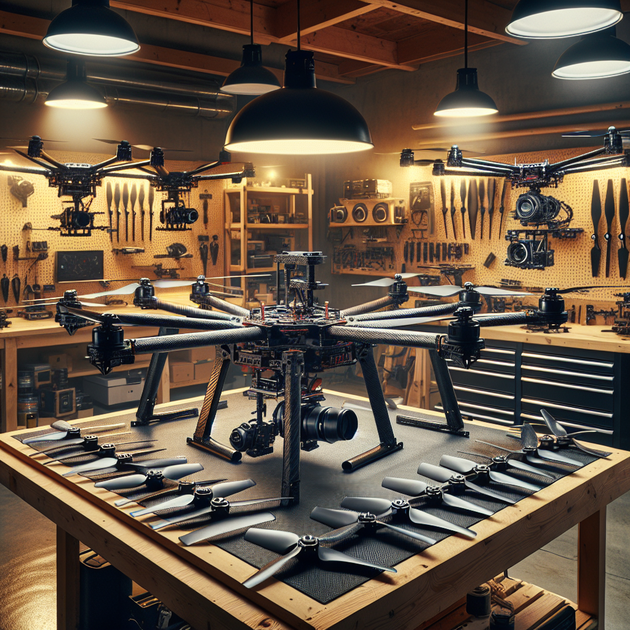Ever stare down a mountain of custom cinelift drone parts and wonder where to even begin? If you’ve just inherited a truckload of heavy lift drone gear—giant quads, hexacopters, beefy pancake motors, and enough carbon fiber props to start a fan shop—you’re not alone. Let’s break down where to start, especially if you’re new to Ardupilot and thinking about launching a drone business.
Understanding Cinelift Drones: What Makes Them Different?
Cinelift drones are a whole different animal compared to 5-inch FPVs. They’re designed to carry heavy camera rigs for professional-grade aerial cinematography. Think of them as the pickup trucks of the drone world. With props in the 14.5–19″ range, custom gimbals, and powerful motors, these machines can lift cinema cameras, big batteries, and all sorts of specialized gear.
The jump from racing drones to heavy lift is huge, but your FPV experience gives you a solid foundation for basic flight skills and build know-how. The main differences? Power systems are much beefier, frame construction is industrial, and flight controllers like Ardupilot are built for precision and automation.
First Steps: Sorting Out Your Cinelift Haul
Before you dive into building or flying, it pays to inventory and understand what you’ve got. Here’s a checklist to get organized:
- Identify all components: Label frames (quads, hexes), motors, ESCs, gimbals, props by size and spec.
- Check compatibility: Not all ESCs or motors will play nicely together—double-check voltage/current ratings.
- Test electronics safely: Use a smoke stopper or bench power supply before plugging in unfamiliar hardware.
- Research each component: Manufacturer websites often have manuals—see if your gear matches popular brands like Freefly Systems or DJI.
- Organize props by size/pitch: Keeping them sorted makes it easier to match them to the right airframe.
Once you know what’s in your collection, you’ll be ready to start planning your first build.
Learning Ardupilot: The Brain of Your Cinelift
If Ardupilot feels intimidating, that’s normal. It’s powerful open-source autopilot software used on everything from hobby quads to commercial UAVs. The good news? There’s a ton of documentation and a helpful community.
To get started:
- Read the official Ardupilot documentation. Their guides cover everything from hardware setup to tuning.
- Download Mission Planner, the recommended ground control software for configuration and firmware updates.
- Start with basic setup: upload firmware, calibrate sensors (compass, accelerometer), assign radio channels.
- Use YouTube tutorials—channels like Painless360 break down complex topics with step-by-step videos.
- Join forums like discuss.ardupilot.org to ask questions and troubleshoot issues.
Ardupilot’s learning curve is real, but once you’ve set up one big quad or hex with it, the others will come easier.
Turning Cinelift Drones Into a Business
Since you’re already Part 107 certified, you’re ahead of the game. Heavy lift drones open doors to commercial gigs that small FPVs can’t handle—think film shoots, industrial inspections, mapping, or even agricultural work.
Here’s how to start building your drone business:
- Build a reliable demo rig: Assemble one airworthy cinelift with a gimbal and camera mount. Use it to build a portfolio.
- Network with local filmmakers and businesses: Offer free demo flights to showcase capabilities.
- Stay compliant: Brush up on FAA rules for heavy drones; large rigs often have extra restrictions or insurance requirements. Check the latest at faa.gov/uas.
- Document everything: Keep logs of builds, flights, maintenance—clients like seeing professionalism.
- Create online presence: Share videos on platforms like YouTube or Instagram to attract potential clients.
A friend once started with a similar gear haul—a garage full of half-built rigs from an old production company. After three months of YouTube tutorials and test flights in local fields (and more than a few emergency landings), he landed his first paid gig filming a real estate promo. Sometimes, getting started is just about building that first solid setup and showing what it can do.
Troubleshooting Common Cinelift Challenges
You’ll run into snags—everyone does with custom heavy lift drones. Some typical issues:
- Vibration problems: Use soft mounts on flight controllers and gimbals; balance props meticulously.
- Power distribution headaches: Check solder joints and use quality wiring rated for high current.
- Tuning woes: Start with conservative PID settings; don’t chase perfect performance right away.
- Gimbal integration: Match the gimbal controller protocol (PWM/SBUS/CAN) to your flight controller output.
There’s no “one right way” to set up a cinelift—but with some patience and community help, you’ll get there.
Ready to Take Off?
Jumping into the world of cinelift drones is daunting but genuinely rewarding. With some methodical learning (and maybe a few late nights puzzling over wiring diagrams), you’ll be flying—and filming—before you know it.
What’s the first project you’d want to tackle with your own cinelift drone? Share your ideas below!

Leave a Reply